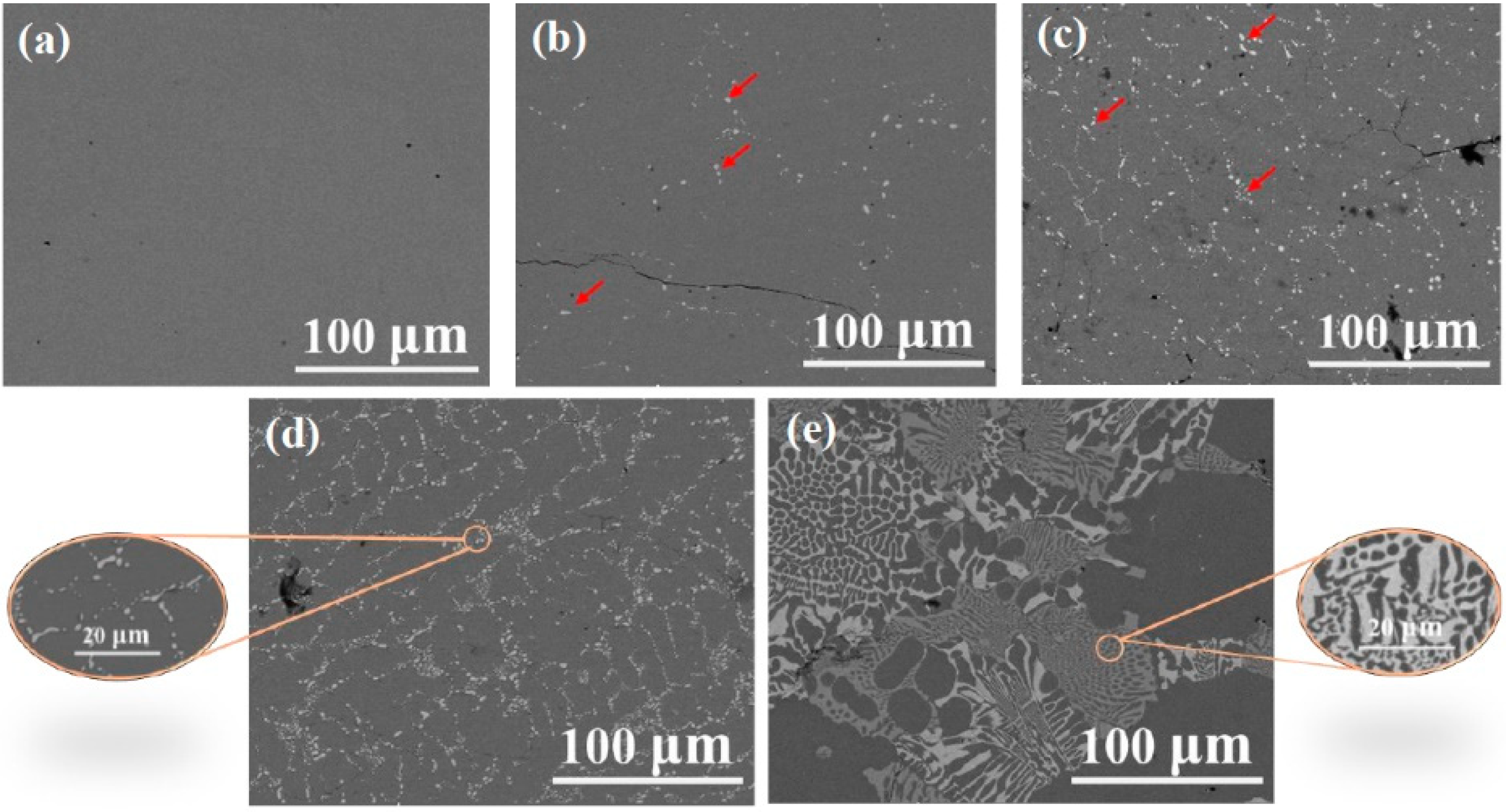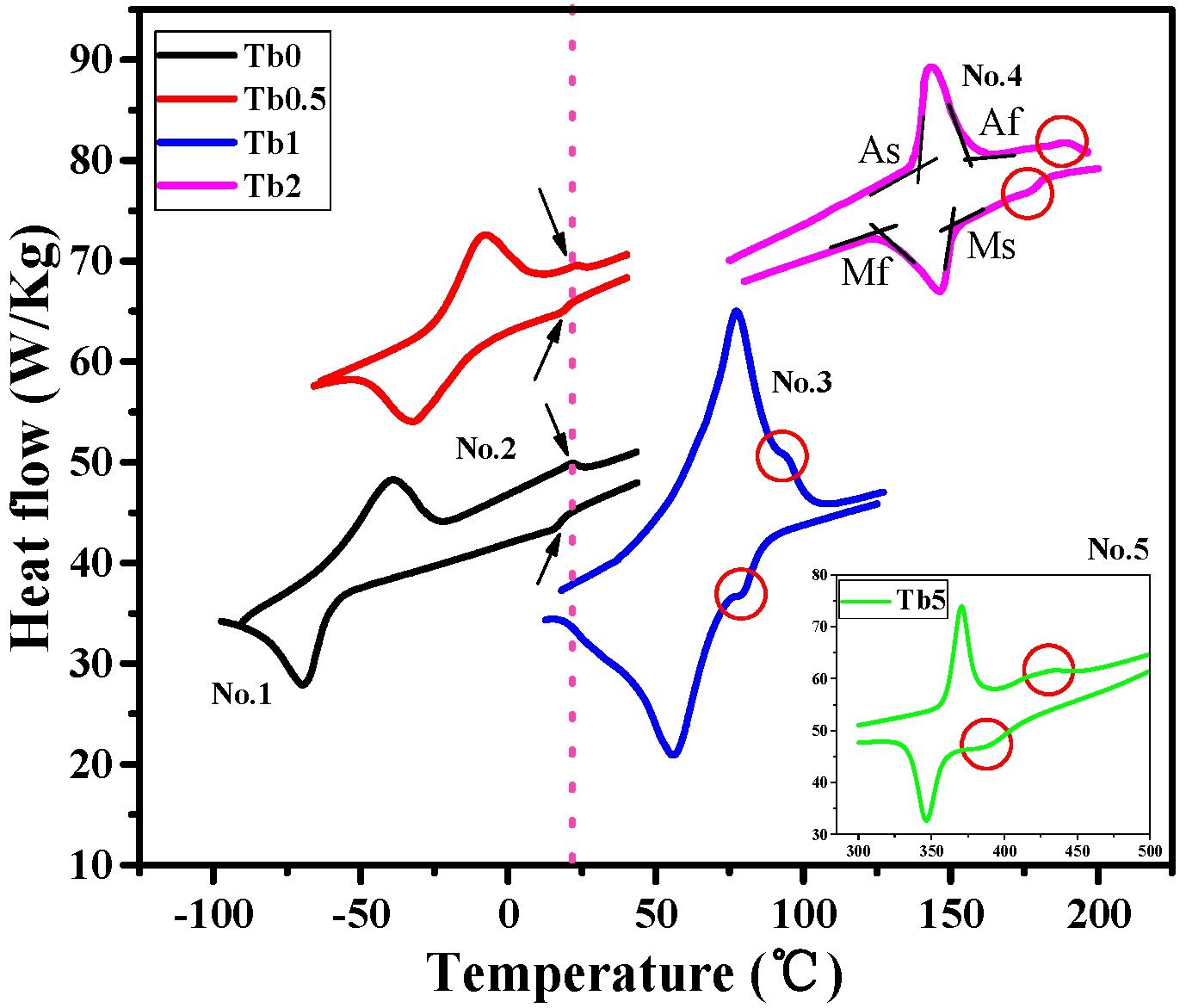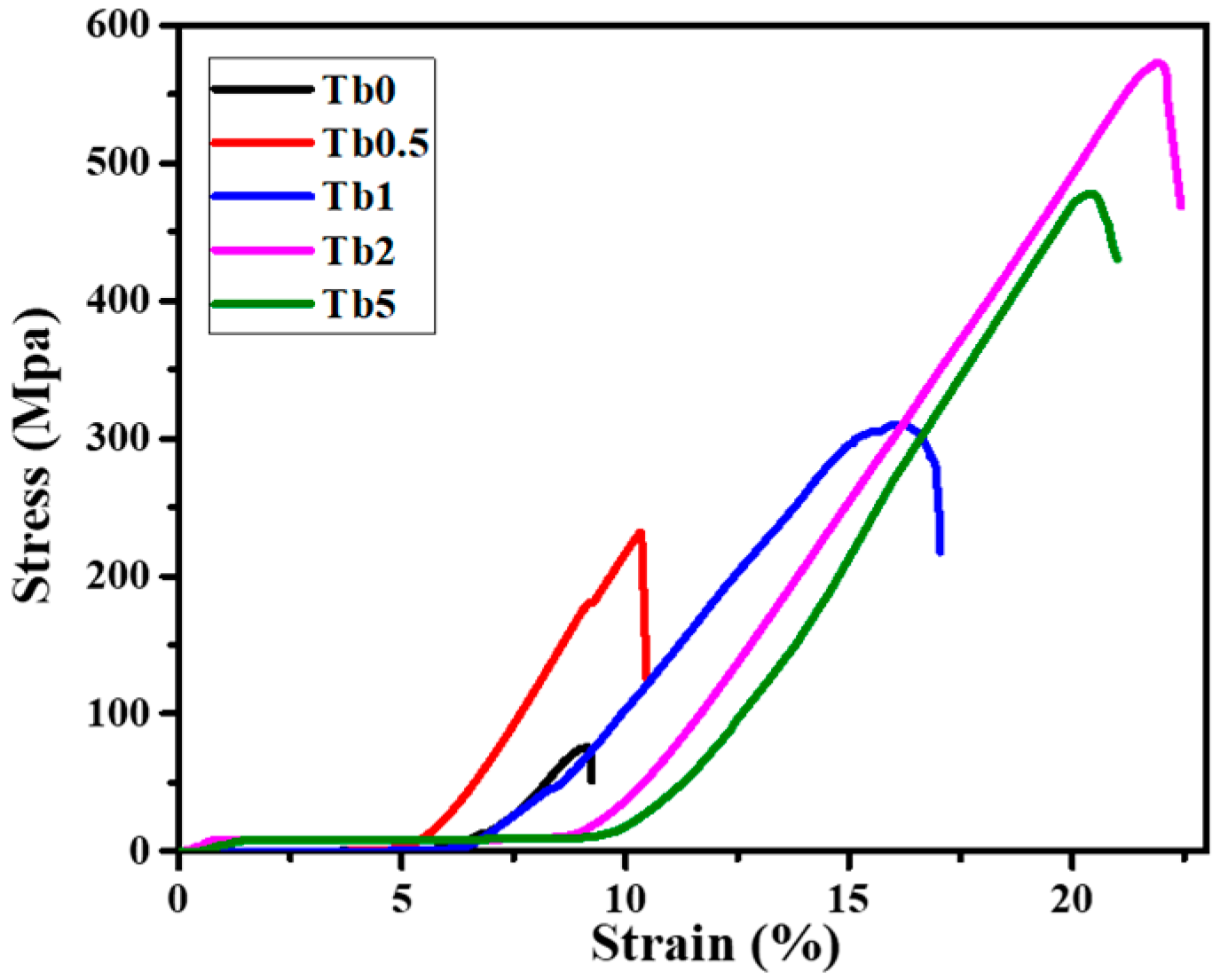Influence of Doping Tb on the Mechanical Properties and Martensitic Transformation of Ni-Mn-Sn Magnetic Shape Memory Alloys
Abstract
:1. Introduction
2. Materials and Methods
3. Results and Discussion
3.1. Structure
3.2. Martensitic Transformation
3.3. Mechanical Properties
4. Conclusions
- The results show that Tb addition refines significantly the grains and causes the formation of a Tb-rich phase. With the increase in Tb content, the Tb-rich phase became larger and tended to distribute along the grain boundaries.
- Martensitic transformation was observed in all Ni48Mn39Sn13−xTbx (x = 0, 0.5, 1, 2, and 5 at.%) alloys. The martensitic transformation temperatures increased remarkably with the increase in Tb content. The martensitic transformation start temperature Ms increased from −60.7 °C for x = 0 to 364.1 °C for x = 5.
- The appropriate amount (2 at.%) of Tb addition in Ni48Mn39Sn13−xTbx (x = 0, 0.5, 1, 2, and 5 at.%) alloys significantly enhanced the compressive strength and improved the ductility, which can be ascribed to the grain refinement. The compressive stress and strain increased, firstly with increasing Tb content up to 2 at.%, and then decreased with the further increased Tb content. The compressive stress increased from 74.3 MPa to 571.8 MPa and the compressive strain increased from 9.2% to 22.0% with increasing Tb content from 0 at.% to 2 at.%.
- When the content of Tb addition was less 2 at.%, the fracture type changed from intergranular fracture to transgranular fracture with increasing Tb content, which was due to strengthening of the grain boundary with increasing Tb content. However, when the amount exceeded 2 at.%, the large amount of Tb-rich phase, hard-brittle phase, had a negative effect on the mechanical properties.
Author Contributions
Acknowledgments
Conflicts of Interest
References
- Ullakko, K.; Huang, J.K.; Kantner, C.; O’Handley, R.C.; Kokorin, V.V. Large Magnetic-Field-Induced Strain in Ni2MnGa. Appl. Phys. Lett. 1996, 69, 1966–1968. [Google Scholar] [CrossRef]
- Sutou, Y.; Imano, Y.; Koeda, N.; Omori, T.; Kainuma, R.; Ishida, K.; Oikawa, K. Magnetic and martensitic transformations of NiMnX(X = In,Sn,Sb) ferromagnetic shape memory alloys. Appl. Phys. Lett. 2004, 85, 4358–4360. [Google Scholar] [CrossRef]
- Murray, S.J.; Marioni, M.; Allen, S.M.; O’Handley, R.C.; Lograsso, T.A. 6% magnetic-field-induced strain by twin-boundary motion in ferromagnetic Ni–Mn–Ga. Appl. Phys. Lett. 2000, 77, 886–888. [Google Scholar] [CrossRef]
- Kainuma, R.; Imano, Y.; Ito, W.; Sutou, Y.; Morito, H.; Okamoto, S.; Kitakami, O.; Oikawa, K.; Fujita, A.; Kanomata, T.; et al. Magnetic-field-induced shape recovery by reverse phase transformation. Nature 2006, 439, 957–960. [Google Scholar] [CrossRef] [PubMed]
- Sozinov, A.; Soroka, A.; Lanska, N.; Rameš, M.; Straka, L.; Ullakko, K. Temperature dependence of twinning and magnetic stresses in Ni46Mn24Ga22Co4Cu4 alloy with giant 12% magnetic field-induced strain. Scr. Mater. 2017, 131, 33–36. [Google Scholar] [CrossRef]
- Sozinov, A.; Likhachev, A.A.; Lanska, N.; Ullakko, K. 10% magnetic-field-induced strain in Ni-Mn-Ga seven-layered martensite. Appl. Phys. Lett. 2002, 80, 1746–1748. [Google Scholar] [CrossRef]
- Karaca, H.E.; Karaman, I.; Basaran, B.; Chumlyakov, Y.J.; Maier, H.J. Magnetic field and stress induced martensite reorientation in NiMnGa ferromagnetic shape memory alloy single crystals. Acta Mater. 2006, 54, 233–245. [Google Scholar] [CrossRef]
- Karaca, H.E.; Karaman, I.; Basaran, B.; Ren, Y.; Chumlyakov, Y.I.; Maier, H.J. Magnetic Field-Induced Phase Transformation in NiMnCoIn Magnetic Shape-Memory Alloys—A New Actuation Mechanism with Large Work Output. Adv. Funct. Mater. 2009, 19, 983–998. [Google Scholar] [CrossRef]
- Soroka, A.; Sozinov, A.; Lanska, N.; Rameš, M.; Straka, L.; Ullakko, K. Composition and temperature dependence of twinning stress in non-modulated martensite of Ni-Mn-Ga-Co-Cu magnetic shape memory alloys. Scr. Mater. 2018, 144, 52–55. [Google Scholar] [CrossRef]
- Bischoff, A.J.; Mayr, S.G. Acoustic emissions associated with stress-induced twin boundary mobility in Fe7Pd3 ferromagnetic shape memory alloys. Scr. Mater. 2017, 139, 162–165. [Google Scholar] [CrossRef]
- Xuan, H.C.; Deng, Y.; Wang, D.H.; Zhang, C.L.; Han, Z.D.; Du, Y.W. Effect of annealing on the martensitic transformation and magnetoresistance in Ni–Mn–Sn ribbons. J. Phys. D Appl. Phys. 2008, 41, 215002. [Google Scholar] [CrossRef]
- Chatterjee, S.; Giri, S.; Majumdar, S.; De, S.K. Giant magnetoresistance and large inverse magnetocaloric effect in Ni2Mn1.36Sn0.64 alloy. J. Phys. D Appl. Phys. 2009, 42, 065001. [Google Scholar] [CrossRef]
- Krenke, T.; Duman, E.; Acet, M.; Wassermann, E.F.; Moya, X.; Manosa, L.; Planes, A. Inverse magnetocaloric effect in ferromagnetic Ni-Mn-Sn magnetic alloys. Nat. Mater. 2005, 4, 450–454. [Google Scholar] [CrossRef] [PubMed]
- Liu, J.; Gottschall, T.; Skokov, K.P.; Moore, J.D.; Gutfleisch, O. Giant magnetocaloric effect driven by structural transitions. Nat. Mater. 2012, 11, 620–626. [Google Scholar] [CrossRef] [PubMed]
- Castillo-Villa, P.O.; Manosaet, L.; Planes, A.; Frontera, C. Elastocaloric and magnetocaloric effects in Ni-Mn-Sn (Cu) shape-memory alloy. Appl. Phys. 2013, 113, 053506. [Google Scholar] [CrossRef]
- Pecharsky, V.K.; Gschneidner, K.A.G., Jr. Giant magnetocaloric effect in Gd5(Si2Ge2). Phys. Rev. Lett. 1997, 78, 4494–4497. [Google Scholar] [CrossRef]
- Tegus, O.; Brück, E.; Buschow, K.H.J.; Boer, F.R.D. Transition-metal-based magnetic refrigerants for room-temperature applications. Nature 2002, 415, 150–152. [Google Scholar] [CrossRef] [PubMed]
- Franco, V.; Conde, A. Magnetic refrigerants with continuous phase transitions: Amorphous and nanostructured materials. Scr. Mater. 2012, 67, 594–599. [Google Scholar] [CrossRef]
- Moya, X.; Kar-Narayan, S.; Mathur, N.D. Caloric materials near ferroic phase transitions. Nat. Mater. 2014, 13, 439–450. [Google Scholar] [CrossRef] [PubMed]
- Sandeman, K.G. Magnetocaloric materials: The search for new systems. Scr. Mater. 2012, 67, 566–571. [Google Scholar] [CrossRef] [Green Version]
- Caron, L.; Ou, Z.Q.; Nguyen, T.T.; Cam Thanh, D.T.; Tegus, O.; Brück, E. On the determination of the magnetic entropy change in materials with first-order transitions. J. Magn. Magn. Mater. 2009, 321, 3559–3566. [Google Scholar] [CrossRef]
- Shen, B.G.; Sun, J.R.; Hu, F.X.; Zhang, H.W.; Cheng, Z.H. Recent progress in exploring magnetocaloric materials. Adv. Mater. 2009, 21, 4545–4564. [Google Scholar] [CrossRef]
- Sun, W.; Liu, J.; Zhao, D.; Zhang, M. Directional solidification and elastocaloric effect in a Ni45Mn44Sn11 magnetic shape memory alloy. J. Phys. D Appl. Phys. 2017, 50, 444001. [Google Scholar] [CrossRef]
- Cai, W.; Gao, L.; Liu, A.L.; Sui, J.H.; Gao, Z.Y. Martensitic transformation and mechanical properties of Ni–Mn–Ga–Y ferromagnetic shape memory alloys. Scr. Mater. 2007, 57, 659–662. [Google Scholar] [CrossRef]
- Singh, R.K.; Raja, M.M.; Mathur, R.P.; Shamsuddin, M. Studies on ferromagnetic shape memory Ni–Mn–Ga alloys with Fe and rare-earths additives. J. Alloys Compd. 2010, 506, 73–76. [Google Scholar] [CrossRef]
- Zhang, X.; Sui, J.H.; Yu, Z.L.; Cai, W. Structure and shape memory effect in a Ni54Mn25Ga20Gd1 alloy with a high transformation temperature. J. Alloys Compd. 2011, 31, 8032–8037. [Google Scholar] [CrossRef]
- Tsuchiya, K.; Tsutsumi, A.; Ohtsuka, H.; Umemoto, M. Modification of Ni–Mn–Ga ferromagnetic shape memory alloy by addition of rare earth elements. Mater. Sci. Eng. A 2004, 378, 370–376. [Google Scholar] [CrossRef]
- Tan, C.L.; Zhang, K.; Tian, X.; Cai, W. Effect of Gd addition on microstructure, martensitic transformation and mechanical properties of Ni50Mn36Sn14, ferromagnetic shape memory alloy. J. Alloys Compd. 2016, 692, 288–293. [Google Scholar] [CrossRef]
- Shen, Q.; Zhao, D.; Sun, W.; Li, Y.; Liu, J. The effect of Tb on elastocaloric and mechanical properties of Ni-Mn-In-Tb alloys. J. Alloys Compd. 2017, 696, 538–542. [Google Scholar] [CrossRef]
- Yuce, S.; Barrio, M.; Emre, B.; Stern-Taulats, E.; Planes, A.; Tamarit, J.L.; Mudryk, Y.; Gschneidner, K.A., Jr.; Pecharsky, V.K.; Mañosa, L. Barocaloric effect in the magnetocaloric prototype Gd5Si2Ge2. Appl. Phys. Lett. 2012, 101, 071906. [Google Scholar] [CrossRef]
- Wroblewski, R.; Leonowicz, M.; Zhao, Z.; Liping, J. Structure and properties of Ni–Mn–Ga magnetic shape memory alloys containing minor addition of terbium. J. Magn. Magn. Mater. 2007, 316, e595–e598. [Google Scholar] [CrossRef]
- Planes, A.; Manosaet, L.; Acet, M. Magnetocaloric effect and its relation to shape-memory properties in ferromagnetic Heusler alloys. J. Phys. Condens. Matter 2009, 21, 1425–1438. [Google Scholar] [CrossRef] [PubMed]
- Jiang, C.B.; Muhammad, Y.; Deng, L.F.; Wu, W.; Xu, H.B. Composition dependence on the martensitic structures of the Mn-rich NiMnGa alloys. Acta Mater. 2004, 52, 2779–2785. [Google Scholar] [CrossRef]
- Zhang, X.; Sui, J.H.; Zheng, X.H.; Yang, Z.Y.; Cai, W. Effects of Gd doping on Ni54Mn25Ga21 high-temperature shape memory alloy. Mater. Sci. Eng. 2014, 597, 178–182. [Google Scholar] [CrossRef]








| Phase | x | Ni | Mn | Sn | Tb |
|---|---|---|---|---|---|
| Matrix | 0 | 47.92 | 38.78 | 13.30 | 0.00 |
| 0.5 | 48.32 | 39.12 | 12.39 | 0.17 | |
| 1 | 48.25 | 40.82 | 10.75 | 0.18 | |
| 2 | 48.78 | 41.47 | 9.58 | 0.17 | |
| 5 | 49.87 | 43.68 | 6.26 | 0.19 | |
| Second phase | 0.5 | 44.78 | 24.03 | 20.88 | 10.31 |
| 1 | 41.85 | 23.70 | 23.27 | 11.18 | |
| 2 | 42.12 | 22.73 | 22.33 | 12.82 | |
| 5 | 41.54 | 21.82 | 22.18 | 14.46 |
| Composition | Ms (°C) | Mf (°C) | As (°C) | Af (°C) |
|---|---|---|---|---|
| Ni48Mn39Sn13 | −60.7 | −83.7 | −61.2 | −25.4 |
| Ni48Mn39Sn12.5Tb0.5 | −16.8 | −49.8 | −24.5 | 6.7 |
| Ni48Mn39Sn12Tb1 | 77.4 | 36 | 49.8 | 42.0 |
| Ni48Mn39Sn11Tb2 | 149.7 | 125.8 | 138.9 | 169.7 |
| Ni48Mn39Sn8Tb5 | 364.1 | 337.9 | 361.7 | 382.3 |
© 2018 by the authors. Licensee MDPI, Basel, Switzerland. This article is an open access article distributed under the terms and conditions of the Creative Commons Attribution (CC BY) license (http://creativecommons.org/licenses/by/4.0/).
Share and Cite
Tian, X.; Zhang, K.; Tan, C.; Guo, E. Influence of Doping Tb on the Mechanical Properties and Martensitic Transformation of Ni-Mn-Sn Magnetic Shape Memory Alloys. Crystals 2018, 8, 247. https://doi.org/10.3390/cryst8060247
Tian X, Zhang K, Tan C, Guo E. Influence of Doping Tb on the Mechanical Properties and Martensitic Transformation of Ni-Mn-Sn Magnetic Shape Memory Alloys. Crystals. 2018; 8(6):247. https://doi.org/10.3390/cryst8060247
Chicago/Turabian StyleTian, Xiaohua, Kun Zhang, Changlong Tan, and Erjun Guo. 2018. "Influence of Doping Tb on the Mechanical Properties and Martensitic Transformation of Ni-Mn-Sn Magnetic Shape Memory Alloys" Crystals 8, no. 6: 247. https://doi.org/10.3390/cryst8060247





